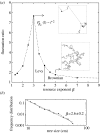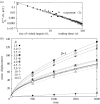Scale-free foraging by primates emerges from their interaction with a complex environment
- PMID: 16790406
- PMCID: PMC1634795
- DOI: 10.1098/rspb.2005.3462
Scale-free foraging by primates emerges from their interaction with a complex environment
Abstract
Scale-free foraging patterns are widespread among animals. These may be the outcome of an optimal searching strategy to find scarce, randomly distributed resources, but a less explored alternative is that this behaviour may result from the interaction of foraging animals with a particular distribution of resources. We introduce a simple foraging model where individual primates follow mental maps and choose their displacements according to a maximum efficiency criterion, in a spatially disordered environment containing many trees with a heterogeneous size distribution. We show that a particular tree-size frequency distribution induces non-Gaussian movement patterns with multiple spatial scales (Lévy walks). These results are consistent with field observations of tree-size variation and spider monkey (Ateles geoffroyi) foraging patterns. We discuss the consequences that our results may have for the patterns of seed dispersal by foraging primates.
Figures




References
-
- Adler F.R, Muller-Landau H.C. When do localized natural enemies increase species richness? Ecol. Lett. 2005;8:438–447. doi:10.1111/j.1461-0248.2005.00741.x - DOI
-
- Atkinson R.P.D, Rhodes C.J, Macdonald D.W, Anderson R.M. Scale-free dynamics in the movement patterns of jackals. Oikos. 2002;98:134–140. doi:10.1034/j.1600-0706.2002.980114.x - DOI
-
- Bartumeus F, da Luz M.G.E, Viswanathan G.M, Catalan J. Animal search strategies: a quantitative random-walk analysis. Ecology. 2005;86:3078–3087.
-
- Binder K, Heermann D.W. Springer; Berlin, Germany: 2002. Monte Carlo simulation in statistical physics.
-
- Bouchaud J.-P, Georges A. Anomalous diffusion in disordered media: statistical mechanisms, models and physical applications. Phys. Rep. 1990;195:127–293. doi:10.1016/0370-1573(90)90099-N - DOI
MeSH terms
LinkOut - more resources
Full Text Sources

